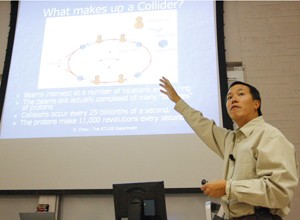The UA physics department’s celebration yesterday was marked by the start-up of the Large Hadron Collider, located 300 feet underground outside of Geneva, Switzerland, on the Swiss and French border.
At 12:30 a.m. Tucson time, the LHC switch was flipped. The halo-like structure, with a circumference of 17 miles, is the scientific completion of 14 years of work for the UA.
Elliott Cheu, the interim associate dean of the College of Science, explained that the university is involved in the ATLAS experiment, one of six experiments located at the LHC.
“”This is a great time for the University of Arizona; it’s a start of the largest experiment ever,”” he said. “”And we at the University of Arizona… play a really key role in the development of this experiment.
“”We’re turning on this experiment, and we hope to probe things that have never been seen before,”” Cheu added. “”We hope with this experiment to really be able to capture and understand some of the most basic questions of the universe. And this experiment will allow us to study the smallest particles that we know. In some sense, you can think of it as a giant microscope.””
“”We hope to catch a glimpse of what happened one-trillionth of a second after the Big Bang, where energy started to form into matter,”” said Michael Shupe, the acting physics department head. “”We hope to understand the origin of the universe, the nature of dark matter and maybe discover all new forms of matter.””
These questions may finally find an answer with the help of the UA, which became involved in the project in 1994. ATLAS was completed just this year, Cheu said, describing the ATLAS as a cylinder-like structure, six stories tall, half a football field long and weighing as much as 100 empty 747s – the largest of the six experiments.
He described how particles will collide inside the ATLAS detector and produce a huge shower of smaller particles, which the ATLAS will measure.
Cheu described how each year, it will produce a stack of information equal to a CD stack four miles high.
The LHC is a collaboration of 2,500 physicists from 37 countries, Cheu said. “”We at the U of A have been doing a great job, and people notice us.””
He described how they presented a better, more compact design for a specific part of the ATLAS.
“”We are the only U.S. institution to have that kind of impact on the design of the ATLAS detector,”” Cheu said. “”It’s a very different detector, and it’s all because of the U of A. And that’s good.””
To put to rest some of the worries that have been circulating, Cheu said that if microscopic black holes were produced, they would not be a problem.
“”This isn’t just a science experiment that’s begun. It’s a moment of real institutional pride,”” Shupe said. “”We are extortionately proud that this university has scholars who have been chosen to play a part in such an international collaboration. You don’t get there just because you want to be there; you get there because you are the best.””









